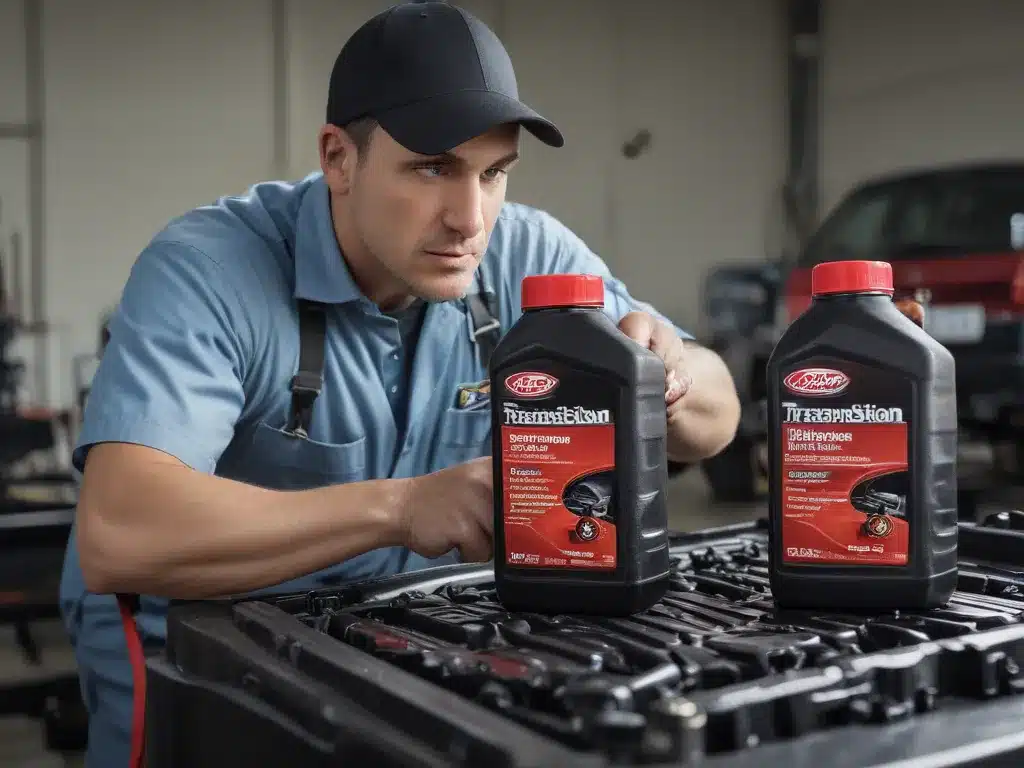
Navigating the Murky Waters of Transmission Fluid Changes
As a car enthusiast, I’ve always been fascinated by the inner workings of vehicles. One aspect that’s particularly intriguing to me is the transmission – that mysterious, often misunderstood component that’s responsible for transferring power from the engine to the wheels. And when it comes to maintaining this crucial system, the question of transmission fluid change intervals has been a topic of much debate.
You see, I’ve noticed that there’s often a disconnect between what the manufacturer recommends and what mechanics advise. Some say you can go forever without a fluid change, while others insist on regular intervals. So, in my quest to get to the bottom of this, I’ve decided to dive deep into the topic and share my findings with you, my fellow auto aficionados.
Manufacturer Recommendations: Longer is Better?
Let’s start by taking a look at what the vehicle manufacturers themselves have to say about transmission fluid changes. In general, they tend to recommend relatively long intervals between fluid changes – often upwards of 60,000 or even 100,000 miles. The reasoning behind this, they’ll tell you, is that modern transmission fluids are engineered to last the lifetime of the vehicle.
However, I can’t help but wonder: is this really the whole story? After all, the manufacturers have a vested interest in minimizing maintenance costs and maximizing the lifespan of their products. And let’s be honest, not all drivers are as diligent about routine maintenance as we enthusiasts are. So, could it be that the manufacturer recommendations are more about covering their bases than providing the optimal service interval?
Mechanic Recommendations: More Frequent Changes
Now, let’s turn our attention to the mechanics. These are the folks who work on transmissions day in and day out, and they often have a very different perspective on fluid change intervals. Many mechanics will adamantly recommend changing the transmission fluid much more frequently – say, every 30,000 or 50,000 miles.
The rationale here is that over time, the transmission fluid can break down, lose its lubricating properties, and even become contaminated with metal shavings and other debris. This can lead to increased wear and tear on the internal components, ultimately shortening the lifespan of the transmission. And let’s not forget that transmissions are complex and expensive to repair – so it’s often better to err on the side of caution when it comes to fluid maintenance.
Real-World Experiences: Anecdotal Evidence
Of course, the only way to truly understand the impact of transmission fluid changes is to look at real-world examples. And that’s exactly what I’ve been doing – talking to car owners, mechanics, and even some transmission specialists to get a sense of how things play out in the real world.
One particularly illuminating conversation I had was with a mechanic named Mike, who’s been working on transmissions for over 20 years. He shared a story about a customer who had faithfully followed the manufacturer’s recommendation and only changed their transmission fluid every 100,000 miles. When the time came for a major overhaul, the transmission was in such poor shape that it had to be completely rebuilt – a job that cost the customer well over $2,000.
On the flip side, I’ve also spoken with owners who’ve religiously changed their fluid every 30,000 miles or so, and their transmissions have lasted well over 200,000 miles with no major issues. These anecdotes certainly seem to lend credence to the mechanics’ perspective.
The Importance of Driving Conditions
Of course, it’s important to note that the optimal transmission fluid change interval can also vary depending on the driving conditions. For example, if you do a lot of towing, hauling heavy loads, or driving in stop-and-go traffic, your transmission is likely under more stress and may require more frequent fluid changes.
Similarly, if you live in a hot or dusty climate, the fluid may break down more quickly, necessitating more frequent changes. And let’s not forget about the age of the vehicle – older transmissions may be more susceptible to fluid degradation, so it’s often a good idea to be more diligent about maintenance as the miles add up.
The Bottom Line: Better Safe Than Sorry
At the end of the day, when it comes to transmission fluid changes, I’m firmly in the “better safe than sorry” camp. While the manufacturer recommendations may seem like a convenient way to minimize maintenance costs, I can’t help but feel that they’re erring on the side of caution – and potentially putting the long-term health of the transmission at risk.
Personally, I tend to follow the mechanics’ advice and change my transmission fluid every 30,000 to 50,000 miles, depending on the vehicle and my driving conditions. It’s a small price to pay to ensure that my transmission continues to operate smoothly and reliably for years to come.
Conclusion: Striking a Balance
So, there you have it – my deep dive into the murky world of transmission fluid change intervals. It’s a complex topic, to be sure, with valid arguments on both sides. But in the end, I believe the best approach is to strike a balance – listening to the manufacturer’s recommendations, but also taking into account the advice of experienced mechanics and your own driving conditions.
After all, when it comes to the health and longevity of your vehicle’s transmission, it’s better to err on the side of caution. And who knows, maybe that extra fluid change or two will be the difference between a smooth, trouble-free ride and a costly repair down the road.
Happy driving, my fellow auto enthusiasts! And remember, if you’re ever in need of a reliable transmission fluid change or other maintenance services, be sure to check out https://autooilandfluid.com/ – they’ve got your back.


